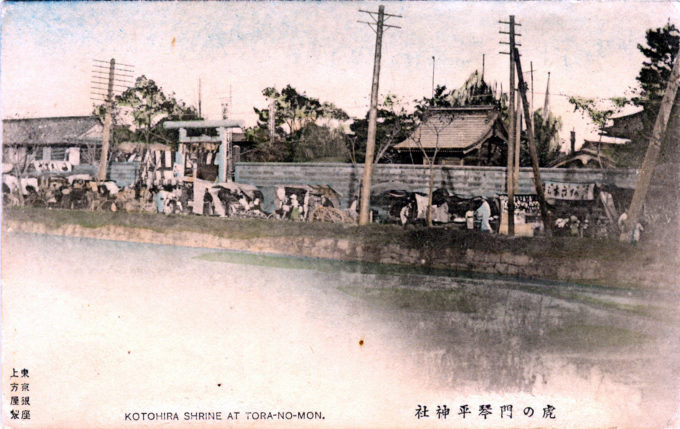“The establishment in 1872 of an organized national indoctrination effort added new ideological and financial priorities to policy decisions at Kotohira Shrine … On the day it announced the Three Standards*, the Ministry of Doctrine granted Kotooka Hirotsune the rank of assistant head priest (gon guji) of Kotohira Shrine, raising him to the highest existing position at the shrine.
“… In order, he hoped, to secure his advancement, Kotooka wielded the wealth of Mt. Zozu [on the island of Shikoku] and its connections to the Toranomon Kotohira Shrine in Tokyo (formerly the popular Konpira shrine at the Marugame lord’s mansion in Edo.) As the focus of the enthusiastic prayers of Tokyo residents, the Toranomon Shrine swarmed with worshippers during the festivals of Konpira held on the tenth day of each month.
“Taking advantage of both the popularity of the Toranomon Shrine and the need of the Ministry of Doctrine for effective sites to educate the populace, Kotooka arranged to build a Shinto lecture hall (Shinto kyokan) on the Toranomon shrine grounds. He received official permission for the project little more than week after receiving his appointment, suggesting that he probably proposed it before receiving his new title.
“… In the popularity of its pilgrimage and the wealth it generated, Kotohira rivaled Ise, the shrine of Amaterasu.”
– Rearranging the Landscape of the Gods: The Politics of a Pilgrimage Site in Japan, 1573-1912, by Sarah Thal, 2005
Kotohira-gu, Toranomon, Tokyo, c. 1910.
1910s • Patriotism/Military • Religious
Tagged with: Government ministries, Kokutai no hongi, Meiji Restoration, Shinto, Shrines, Temples/Shrines (Misc), Toranomon
Please support this site. Consider clicking an ad from time to time. Thank you!


